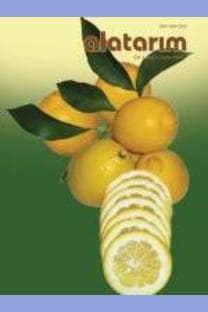Küresel ısınma ve tarımsal uygulamalara etkisi
küresel ısınma, sera gazları, hava sıcaklığı, enerji kaynağı, yenilenebilir kaynaklar
Global warming and effect on agricultural applications
___
- Anonim, 2001. IPCC (Intergovernmental Panel on Climate Change), 2001. Contribution of Working Group II to the Third Assessment Report of the Intergovernmental Panel on Climate Change. Cambridge: University Press, 2001.
- Anonim, 2002. IPCC (Intergovernmental Panel on Climate Change), “Climate Change and Biodiversity”, Technical Paper V.
- Anonim, 2004. OECD Economic Survey: Turkey. http://www.oecd.org/dataoecd/42/47/33821199.pdf.
- Anonim, 2005. IEA, (International Energy Agency). Energy Policies of IEA Countries: Turkey.Paris. 2005 Turkey Country Report.
- Anonim, 2006. TUİK, Seragazı Emisyon Envanteri, 1990-2004. Sayı:197.
- Arıkan, Y., 2003. “Kyoto Protokolü Öncesinde Değişen İklim, Kızışan Müzakereler ve Türkiye”, 9. Türkiye Enerji Kongresi, DEK-TMK, İstanbul.
- Ceran, Y., 2005. Sulak Alan Değerleri ve İşlevleri. Çevre ve İnsan 60 s:30-37.
- Doğan, S., 2005. Türkiye’nin Küresel İklim Değişikliğinde Rolü ve Önleyici Küresel Çabaya Katılım Girişimleri. Ç.Ü. İktisadi ve İdari Bilimler Dergisi, Cilt 6, Sayı 2: 57-73.Adana.
- Goyal, R.K., 2004. Sensitivity of Evapotranspiration to Global Warming: A Case Study of Arid Zone of Rajasthan (India). Agricultural Water Management 69: 1–11.
- Houghton, R.A., 2003. Why Are Estimates of The Terrestrial Carbon Balance So Different? Global Change Biology, v.9, p.500-509.
- Houghton, J., 2005. Global Warming. Rep. Prog. Phys. 68 1343-1403.
- Khasnis, A.A., Nettleman, M.D., 2005. Global Warming and Infectious Disease. Archives of Medical Research 36, 689–696.
- King, D., 2005. Climate Change: The Science and The Policy. Journal of Applied Ecology 42,779–783.
- Lal, R., 2006. Enhancing Crop Yields in The Developing Countries Through Restoration of The Soil Organic Carbon Pool in Agricultural Lands. Land Degradation and Development,v.17, p.197-209.
- Maccracken, M.C., 2001, Global Warming: A Science Overview, pp. 151-159 in Global Warming and Energy Policy, Kluwer Academic/Plenum Publishers, New York, 220 pp.
- Pathak, H., Wassmann, R., 2007. Introducing Greenhouse Gas Mitigation as A Development Objective in Rice-Based Agriculture: I. Generation of Technical Coefficients. Agricultural Systems 94:807–825.
- Siqueira, O.J.F., Steinmetz, W.S., Salles, L.A.B., Fernandes, J.M. 2001. Efeitos Potenciais das Mudanças Climáticas na Agricultura Brasileira e Estratégias Adaptativas Para Algumas Culturas. In: Mudanças Clımatıcas Globaıs E A Agropecuarıa Brasıleıra, 1., Jaguariuna,Proceedings. Jaguariuna: Embrapa Meio Ambiente,. p.33-64.
- Şahin, Ü., 2007. Türkiye İçin Geliştirilen Bir Örnek Acil Eylem Planı. Yeşiller İklim Değişikliği Acil Eylem Planı, Şubat 2007. www.yesiller.org.
- Tunç, G. İ., Aşık, S.T., Akbostancı, E., 2007. CO2 Emissions vs. CO2 Responsibility: An Input-Output Approach for The Turkish Economy. Energy Policy 35, 855–868.
- ISSN: 1304-2653
- Yayın Aralığı: 2
- Başlangıç: 2015
- Yayıncı: Alata Bahçe Kültürleri Araştırma Enstitüsü
Gök Serpil TANGOLAR, Fuat ERGENOĞLU, Saadat BÜYÜKALACA
Doğu akdeniz bölgesi kayısı bahçelerinde entegre mücadele uygulamaları ve eğitim çalışmaları
Ayla YILDIZ, Ahmet YILDIZ, İlhan DORAN, İlhan AYDIN, Davut KELEŞ
Küresel ısınma ve tarımsal uygulamalara etkisi
Haploid bitki elde etme yollarından biri: Mikrospor kültürü
Türkiye’de muz yetiştiriciliği, sorunları ve çözüm önerileri
